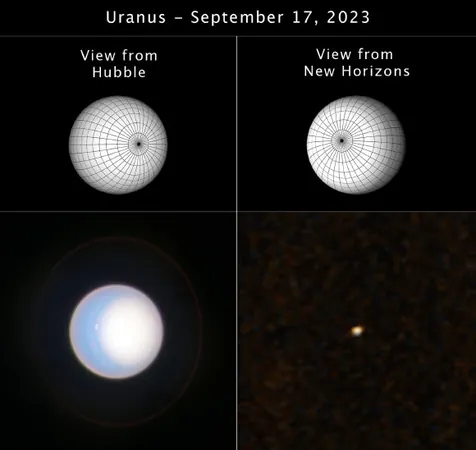
Hubble and New Horizons Work Together to Unlock Secrets of Uranus!
2024-10-10
Author: Sarah
Introduction
In an exciting development, astronomers are harnessing data from both the NASA/ESA Hubble Space Telescope and NASA’s New Horizons spacecraft to gain new insights into the ice giant planet Uranus. By comparing high-resolution images captured by Hubble with the far-off views from New Horizons, researchers are setting the groundwork for interpreting data from future observatories focused on exoplanet exploration.
Why does this matter?
Direct imaging of exoplanets is revolutionary in our understanding of their potential habitability and offers critical clues about how our Solar System formed. Yet, capturing images of these distant worlds is incredibly challenging. Exoplanets often appear as mere pinpoints of light far beyond the reach of our current telescopes, making detailed analysis tricky.
Techniques Used
Astronomers employ both direct imaging and spectroscopy techniques to gather light from these exoplanets in order to assess their atmospheres. However, they can only capture images of exoplanets when they are in 'partial phases,' which means only segments of the planets are illuminated by their host stars as seen from Earth.
Uranus as a Subject of Study
Uranus became a prime subject for this study for several reasons. First and foremost, many known exoplanets are gas giants, much like Uranus itself. At the time of the observations, New Horizons was positioned a staggering 10.5 billion km (6.5 billion miles) away on the opposite side of Uranus. This unique perspective allowed scientists to investigate the planet's evening crescent—something that is virtually impossible to achieve from our own planet.
Observations by New Horizons and Hubble
While New Horizons provided only a pixelated glimpse of Uranus through its Multispectral Visible Imaging Camera, Hubble shone brightly with its superior resolution, unveiling atmospheric features like clouds and storms on the illuminated side of the planet.
Researcher Insights
“I expected Uranus would look different in various filters, but we found it was actually dimmer than we predicted with data from New Horizons,” explained Samantha Hasler, a researcher from MIT. The findings raise intriguing questions about how the atmospheres of gas giants, including those outside our Solar System, behave.
Implications for Exoplanet Studies
Remarkably, both Hubble and New Horizons noted that Uranus's brightness didn’t fluctuate with the planet’s rotation, suggesting that its cloud patterns remained relatively stable over time. What does this mean for the study of exoplanets? The New Horizons data provides groundbreaking evidence that gas giants might reflect light differently depending on their phase angle—a critical piece of information when predicting how exoplanets will appear in future observations.
Significance of Findings
Dr. Alan Stern, principal investigator for New Horizons, emphasized the significance of these findings: 'These landmark studies of Uranus from an unobservable vantage point contribute immensely to our scientific understanding and surprise us with new revelations about the Solar System.'
Future Missions
Future missions promise to build on this knowledge. The upcoming Nancy Grace Roman Space Telescope, expected to launch by 2027, will utilize a coronagraph to block out starlight, allowing researchers to capture clearer images of gas giant exoplanets. Additionally, NASA’s Habitable Worlds Observatory is in the early planning stages and aims to be the first instrument dedicated solely to searching for atmospheric biosignatures on Earth-sized planets orbiting distant stars.
Conclusion
By establishing a clearer understanding of how planets like Uranus appear in distant imagery, scientists are better preparing for the challenges that lie ahead in the quest for signs of life beyond our Solar System.
Presentation of Findings
The results from this groundbreaking study were recently presented at the DPS56, the American Astronomical Society's Division for Planetary Sciences annual meeting, showcasing the exciting trajectories of modern astronomy.
Looking Ahead
Stay tuned as we continue to unravel the mysteries of our universe—who knows what brilliant discoveries lie ahead!



 Brasil (PT)
Brasil (PT)
 Canada (EN)
Canada (EN)
 Chile (ES)
Chile (ES)
 España (ES)
España (ES)
 France (FR)
France (FR)
 Hong Kong (EN)
Hong Kong (EN)
 Italia (IT)
Italia (IT)
 日本 (JA)
日本 (JA)
 Magyarország (HU)
Magyarország (HU)
 Norge (NO)
Norge (NO)
 Polska (PL)
Polska (PL)
 Schweiz (DE)
Schweiz (DE)
 Singapore (EN)
Singapore (EN)
 Sverige (SV)
Sverige (SV)
 Suomi (FI)
Suomi (FI)
 Türkiye (TR)
Türkiye (TR)